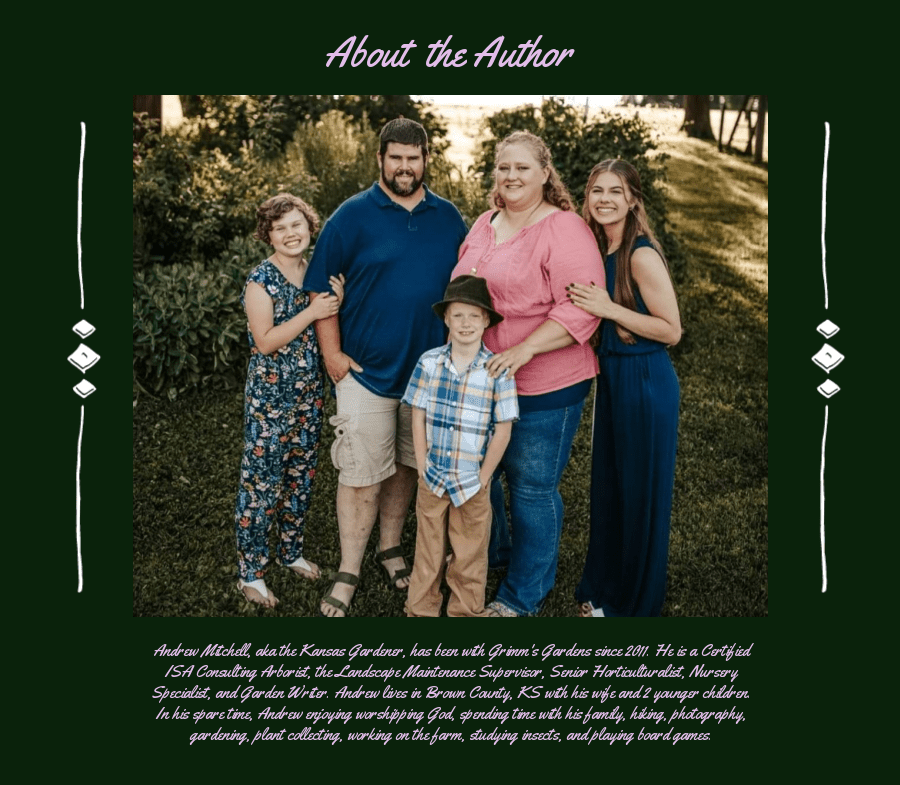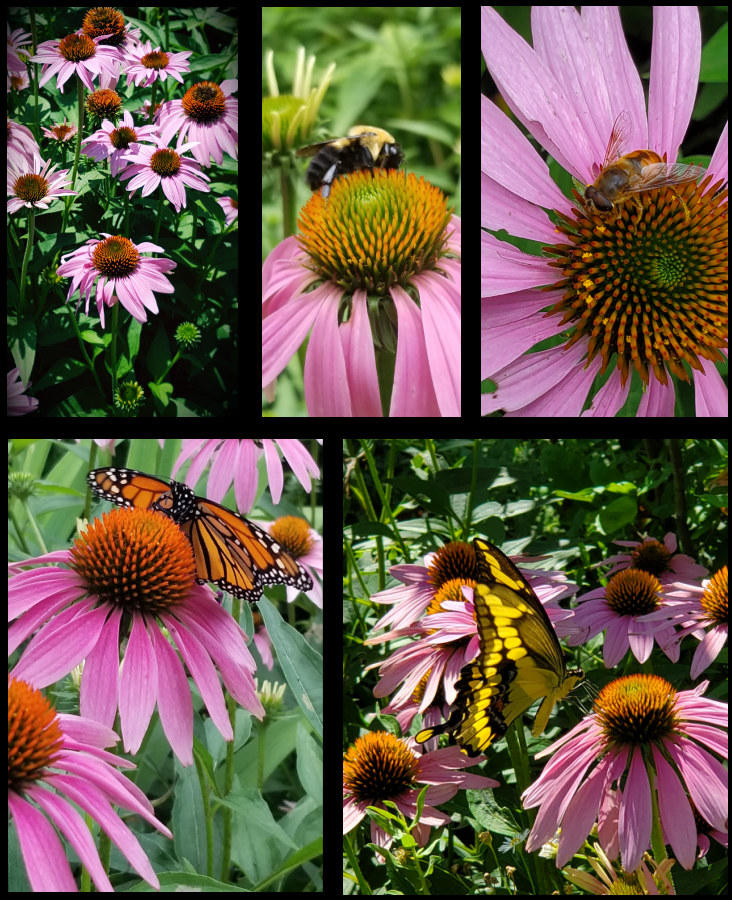I have already gone over many of the plants which are best for new gardeners, but what about native perennials? Some of the plants listed in my other blog were natives, but this list is only natives. These native perennials are easy to grow, usually bloom in the first year or plantings, are host plants for butterflies and moths, and provide nectar for a wide range of insect pollinators. Also, many of them are long lived in the garden.
When it comes to choosing natives for you garden, there is a lot to think about, just like when choosing other plants. You must think about the amount of sunlight, the soil, and the water requirements or climate of your area. Here in the Central Great Plains, we have a variety of ecosystem types, including prairies, woodlands, glades, and wetlands. Your own landscape may be any of these, or a combination.
In my own personal landscape, I have woodland, woodland edge or glade, and prairie. If my wife and I decide to build a pond in the future, we will also have wetland. The best thing to do is to separate native perennials into these groups. And these native perennials are easy to grow and care for as well. There are thousands of native plants, but many are too finicky specialists in a specific soil or region to be grown commonly by most gardeners.
Native Perennials for the Woodlands
The woodlands include areas of dense or dappled shade, which is created by different types of deciduous and evergreen trees. Generally, woodlands with deep shade have evergreen cover, or dense trees such as oak and maple. Dappled shade woodlands often have more open or sparse deciduous trees such as hickory, elm, linden, hackberry, Kentucky coffeetree, and honeylocust. Or you might have a mixed woodland, with several areas of dense shade and areas of dappled shade.
Native perennials for woodlands which are easy to grow, may fall into 2 categories, either ephemerals or other. Ephemerals mainly produce both leaves and flowers in spring, before the leaves of the trees overhead have fully leafed out. Or, as in the case of several orchids, they may produce leaves early, which then die back in the heat of summer, and flower stalks come up in late summer or autumn.
Easy to Grow Ephemerals
- Rattlesnake fern, Botrychium virginianum – this is not a true fern, but a relative. I was able to successfully transplant one from a construction site to my woodland garden in 2020. It has come up every year since, flowered, and died to the ground by mid-July. Though not showy, they are a nice native to add to the woodland.
- Dutchman’s Breeches, Dicentra cucullaria – an interesting little plants, there are many species of Dicentra across the country. Here, it grows only about 9 inches tall with the flowers, which are either white or pinkish. And great spreading plant for the woodland garden.
- Bloodroot, Sanguinaria canadensis – this is one of my favorite early spring wildflowers. I first came across it at the Overland Park Arboretum on a wildflower hike in April, 2018. Since then, I have located a large population of it in Atchison County, and have added it to my woodland garden. The flowers are pure white and bloom only for about a week. The leaves may stay on through July, but become large and distorted.
- Shooting Star, Dodecatheon meadii – this awesome native has cool, upside-down flowers that resemble a shooting star. They can be pink or white, and bloom in early spring.
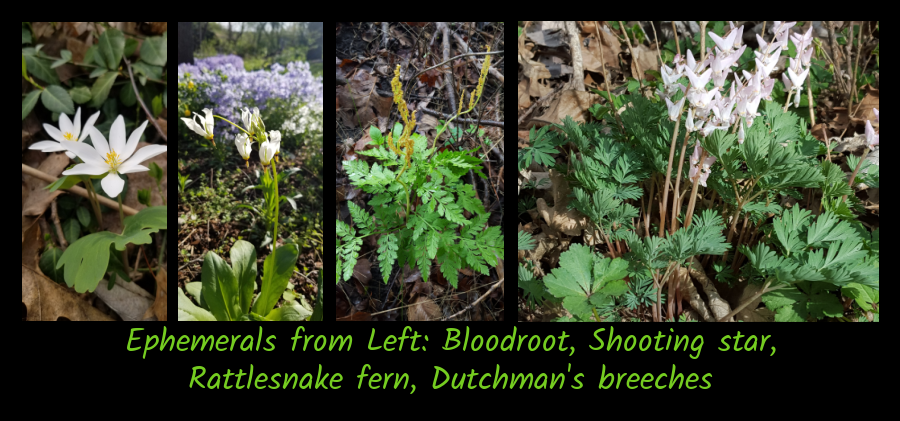
Other Native Perennials for the Woodland Garden
- Wild ginger, Asarum canadense– besides being a reliable groundcover, the roots of this plant smell like ginger, and can be used in place of the tropical ginger root. The flowers are small, reddish-brown and almost invisible, unless you are looking for them.
- Elm-leafed goldenrod, Solidago ulmifolia – one of my favorite native perennials, this goldenrod is best planted either in the glade or the woodland itself. It does prefer to be shaded, unlike most of the other goldenrods. Also, it is the host plant for over 40 species of moths.
- Virginia waterleaf, Hydrophyllum virginianum – is probably the easiest groundcover for shade to get started. And it may be difficult to take out too, but in the woodland, is is perfect. The leaves are dappled green with white blotches, and the flowers are neon pink and attractive to a lot of bees.
- Indian pink, Spigelia marilandica – a new addition to my garden in 2022, it bloomed all summer long from the bareroot plants I put in. I was very impressed by the bright red and yellow flowers, and it attracted hummingbirds!
- Blue woodland phlox, Phlox divaricata – I have used this extensively in my garden, and for my customers. Not only is it easy to plant and grow, it is semi-evergreen, and flowers bloom for a long time, usually about 6 to 8 weeks. The flowers can be blue, lavender, pink, or white. A few moths use it as a host plant.
- Pitcher’s Leatherflower, Clematis pitcherii – a vining plant for the woodlands, this native is unlike the big, showy clematis of the garden. The flowers are small and bell-shaped, hanging upside-down. I love min because it is so unique. I have seen many bumblebees on the flowers.
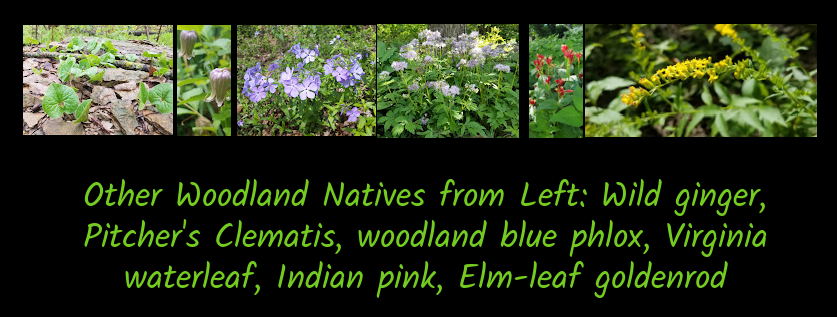
Native Perennials for the Glade
What is a glade? Well, a glade is an open area like a meadow, surrounded by woodlands. For our purposes, it is a partial sun or shade area, that is not actually under trees, but near them. Many of these plants may already be in your gardens, under cultivar names, and in full sun. But they like a little shade, especially afternoon shade in the Central Great Plains region.
Bluestar, Amsonia species
There are several species of bluestars, and all of them do well in either the glade or meadow garden setting. I have Amsonia hubrichtii, Threadleaf bluestar in my Entry Garden, which is part shade. The flowers of all the bluestars are bright blue, or sky blue, and only bloom for a few weeks. But the foliage turns butterscotch yellow in autumn, making it a worthwhile addition. Also, they are easy to grow.
Purple milkweed, Asclepias purpurascens
A plant that prefers the glade, I have added it to my Monarch Waystation area, which is part sun. Actually, everything south of my house, the front yard area, could be considered a glade, as it is surrounded by trees. Purple milkweed is almost ephemeral, coming up early and blooming in April, May, and June, then virtually disappearing after that. Like all milkweeds, it is used as a host by Monarchs, Queens, cycnia moths, and milkweed tussock moths.
Sweet Joe Pye Weed, Eutrochium purpureum
A common plant in many gardens, sweet Joe Pye is a glade lover. It is easy to care for, and attracts a lot of butterflies and bees with its whitish-pink to pink flowers in July and August. At least 6 species of moths use it as a host plant.
Golden Glow, Rudbeckia laciniata
A lot of you probably have a cultivar of golden glow in your garden. I have one myself, ‘Goldquelle’, a double-flowered variety I got from my Grandmother’s garden when she passed. I often find golden glow growing wild in woodland glades in Northeast Kansas. It is an easy plant to transplant and grow. Several moths and the Silvery Checkerspot butterfly use it as a host plant.
Drummond’s Aster, Symphyotrichum drummondii
A great little woodland aster species, it grows best in the glade with part sun. The flowers are blue or lavender-pink, and I believe some white variants may be possible. The leaves are basal and heart-shapes. Over 40 species of moths and at least 2 butterflies use it as a host plant. And many bees and butterflies visit the flowers, which bloom in later summer and fall.
Obedient Plant, Physostegia virginiana
A beauty with white or pink flowers, you can actually move the individual flowers on the stem and they stay where you move them. Hence the name “obedient” plant. They are rhizomatous, meaning they grow from underground, horizontal roots. And they are easy to care for. Give them a little sun, and a little shade, and a little water, and they are happy. Hummingbirds and bees are attracted to the flowers.
Fall Phlox, Phlox paniculata
A lot of gardeners probably already have this native perennial in their gardens, in the form of a cultivar. It grows wild in my glade, and I have identified it all over Brown and Atchison counties in Kansas. Fall phlox is a great late summer and fall bloomer for butterflies. I usually see a lot of tiger swallowtails on it, as well as other swallowtails. Flowers are usually pink, but can be coral, red, white, lavender, or multi-colored if you choose a cultivar.

Easy to Grow Native Perennials for the Wetland
I do not do much work with wetland species myself, other than identification and pollinator photography, but there are several nice wetlands within 10 miles of my house. Besides the local lake, the Atchison County Lake in Northeast Kansas is a favorite. Also, there are many local walk-in-fishing ponds which I go to to hunt wildflowers and insects. Several of the following plants I have in my gardens, and I have to give them extra water because I have them away from the pond edges they prefer.
Marsh milkweed, Asclepias incarnata
It does well in dry locations, but I try to plant marsh milkweed where it can soak up the moisture. I find it often in waterways and ditches along fields. It would be a great plant for a rain garden, as it can handle both drought and wet periods. The flowers are typically pink, although a subspecies from Minnesota is white. Besides being a host plant for monarch butterflies, the flowers attract a range of bees, butterflies, beetles, and wasps.
Cup plant, Silphium perfoliatum
One of the first times I found this growing wild was in my own backyard, next to the water meter. And then again, in the ditch between the drive and my front yard. It prefers to be wet. A customer of mine in Sabetha, KS, has it growing under the eaves of their barn, where rainwater falls on it (they do not have gutters). Cup plant gets tall, as big as 8 feet, but it can be cut back before July 1st, and still bloom on shortened plants. Flowers are similar to a sunflower, and bright yellow. Birds like to eat the seeds.
New England Aster, Symphyotrichum novae-angliae
I was pleasantly surprised to find this native growing by a pond on a wildflower hike in 2018, at Klinefelter Farm by Hiawatha, KS. Since then, I have found flower color variations growing in the ditch by my house and my neighbor to the west. It is easy to transplant and grow, if you have a wet spot or a rain garden. Flower color is purple, pink, mauve, or white (rarely). I have 2 shades of pink and purple in my gardens. More than 40 moth species use it as a host, while bees, butterflies, moths, and other insect pollinators flock to the autumn flowers.
Great blue lobelia, Lobelia silphilitica
Another first discovery for me was in a ditch southeast of Grimm’s Gardens, along a road I like to take home sometimes because of all the natives growing along it. The flowers are bright to dark blue, sometimes white, and bloom for several weeks in late summer and fall. Plants are easy to grow and are drought tolerant for a few weeks. One of my clients has a low spot in the garden where water collects and I used this plant along with some other bog or wetland lovers.
Virginia Mountain mint, Pycnanthemum virginianum
Found in only a few Kansas counties, but widespread eastward, I found it also at Klinefelter Farm on a wildflower hike. The plants are very aromatic, smelling strongly like spearmint, and can be used as such in tea and other recipes. The flowers are white with a hint of lavender, and bloom in late spring and early summer. Mountain mints are easy to grow and transplant, and are not aggressive. Bees, wasps, butterflies and others visit the flowers.
Culver’s root, Veronicastrum virginicum
Preferring wet soils, this native perennial has white or violet flowers. The plants are upright, and do well in the center of a rain garden, or bog. The spiked flowers attract a lot of bees, wasps, and butterflies. And, the foliage turns butterscotch yellow in autumn, similar to bluestar. I have this plant in my Monarch Waystation and Sunny Cottage Garden.

Easy to Grow Natives for the Prairie or Meadow Garden
When I started my Meadow Garden in 2018, I did not even think of it as a meadow. It was just a sunny bed in the backyard where I only planted native perennials and annuals. Some things were already there, like the cup plant, smooth sumac, and broomsedge bluestem. But I have added a lot of things too it since. Now, it is the Meadow Garden, and contains natives from local prairies (seed sourced) and from my family’s properties in the Smoky Hills of North Central Kansas.
Meadow or prairie garden plants are drought tolerant, prefer at least 8 hours of direct sun, and can handle our wind and weather changes. These plants are easy to transplant, grow, and take care of. I usually burn off my meadow (and the Monarch Waystation) in early February.
Rattlesnake master, Eryngium yuccafolium
One of my favorites, it does grow well in a glade type garden, as well as the prairie. Jut a mile and a half from my home is a native prairie remnant with rattlesnake master growing on the side of a hill. It is too steep to till, so it is cut once a year for hay. The rattlesnake master, which has white flowers, survives the hay cutting and blooms again on new growth. The flowers attract bees, wasps, and butterflies. At least 1 moth uses it as a host plant.
Butterfly Milkweed, Asclepias tuberosa
It would hardly seem like a post about native perennials without butterfly milkweed. The flowers are either orange, yellow, or orange-red, and it blooms for 4 to 10 weeks in May, June, and July. The plant is a host for monarchs mainly, while the flowers attract bees, butterflies, moths, wasps, beetles, and more. It is one of the most rewarding native perennials to grow.
Purple coneflower, Echinacea purpurea
While this is probably the shortest-lived native on my list, it is easy to grow and it reseeds all over, but is not thuggish. Purple coneflower can come in a range of colors, but I like the purple-pink ones best for the meadow. Several butterflies and moths use it as a host plant, while bees, butterflies, and other pollinators flock the flowers. It blooms from June to September in most parts of the Central Great Plains.
False sunflower, Heliopsis helianthoides
Similar to a sunflower, false sunflower has bright yellow flowers. The plant grows easily from seed, and indeed, reseeds easily. In the meadow, it blooms from June to September, making it great for new gardeners. The flowers attract bees and butterflies mainly. A handful of moths use it as a host plant.
Prairie blazingstar, Liatris pyncnostachya
A great and easy plant to grow, prairie blazingstar does very well in either the meadow or a cottage garden. I have it in both. The flowers are usually purple-pink, but their are white cultivars available. I have seen countless bees visiting the flowers, along with butterflies, moths, and wasps. A few moth species also use the plant as a host.
Prairie Dock, Silphium terabinthinaceum
One of the longest lived native perennials I have come across, this might be the only species you have to wait for flowers from. it prefers to settle its roots after transplanting, and I had to wait 3 years for mine to start blooming. The yellow flowers grow on 3 to 9 foot stalks above the large leaves. Bees, butterflies, moths, and beetles all use the flowers.
Wild indigo, Baptisia australis
Even though I have 11 cultivars and am adding 2 more (at least) in 2023, I still love the native. All the baptisias (except B. bracteata, Cream Wild Indigo), are easy to grow in the garden. Flowers are purple or bluish on the original species. Several skippers and moths use the plant as a host, while bumblebees and butterflies are the primary pollinators. The flowers begin to bloom in May and go through June.
Wild senna, Senna marilandica
Another rewarding plant, wild senna is very drought tolerant. I planted one in late 2021, and totally forgot about it until it began blooming in mid-summer of 2022. I was surprised and excited, for I knew that several butterflies use it as a host plant. The flowers are bright yellow and the leaves are interesting, almost tropical.
Aromatic aster, Symphyotrichum oblongifolium
My second favorite of the asters, aromatic aster is short and stocky, rarely getting taller than 3 feet. It blooms from August to November in the Central Great Plains, and I have seen it blooming still on December 1st in Manhattan, KS at the Flint Hills Discovery Center. Bees, butterflies, and moths all visit the purple flowers. The silvery checkerspot butterfly and some moths use it as a host plant.
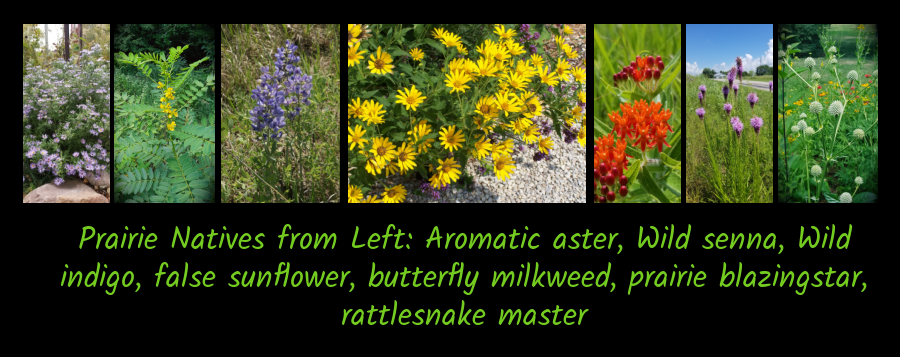
Conclusion
Many native perennials can be quite easy to grow and take care of, as long as you plant them where they will thrive. Picking the right pant for the right place should be done with everything, not just natives for new gardeners. Natives may be more forgiving though, since they have been with their climate since the flood. I hope you have a god time finding native perennials best suited for your landcape.
Happy planting!
